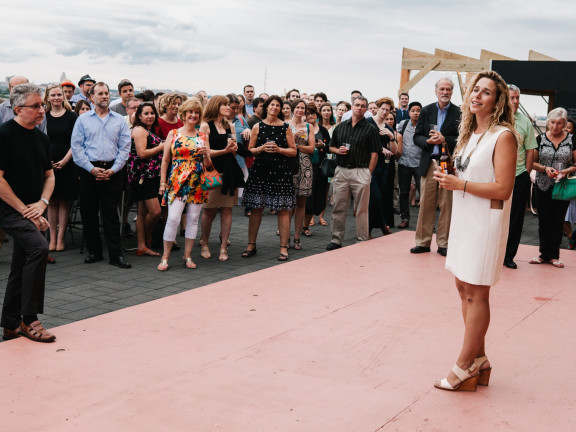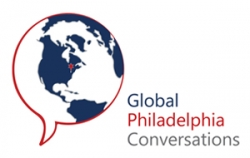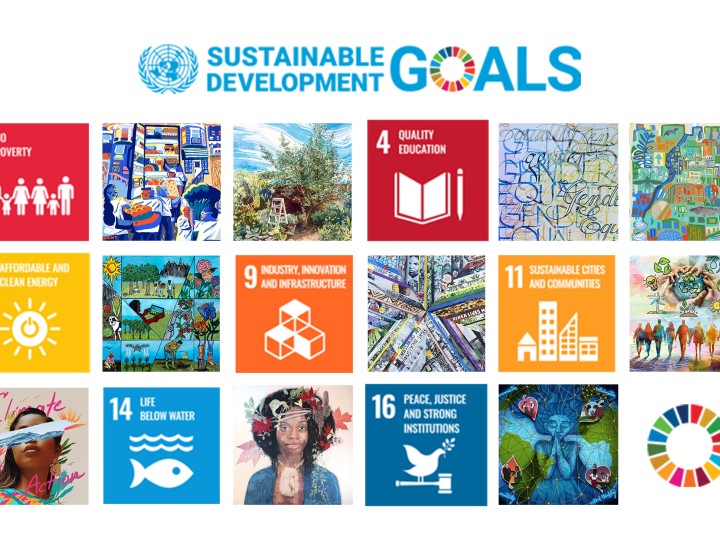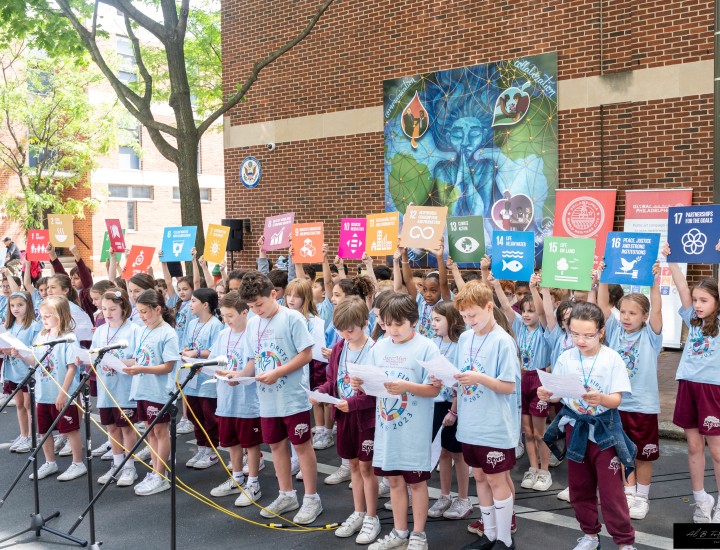A Global Conversation with Lindsey Scannapieco

In Philadelphia, a city where historic buildings often sit dormant, Lindsey Scannapieco is finding new ways to bring them back to life.
As founder and managing partner of Scout, Scannapieco works to breathe new life into the city where she grew up — repurposing neglected buildings into community spaces. Her projects prioritize upholding Philly’s vibrant art scene and ensuring that residents feel heard as the city develops.
Currently, Scannapieco is working to repurpose a former University of the Arts property, the historic Hamilton and Furness building, into a space for creatives — called the Village of Industry and Art. Her team is also planning to convert its former dormitories into affordable housing for artists.
For her work with Scout, Scannapieco will receive the 2025 Globy Award for Sustainable Development Leadership from Global Philadelphia Association this December. We spoke with her about her work and how it contributes to conversations about sustainable development in Philly, across the country and around the world.
Julia Boehning: Would you mind introducing yourself for our readers? Tell us about you and the work you do.
Lindsey Scannapieco: My name’s Lindsey, and I’m the founder of Scout. We’re an urban design development practice headquartered here in Philadelphia, and for the last 10 years, the project we’re probably best known for is the redevelopment of the Bok Building in South Philadelphia — which is a 340,000-square-foot historic high school we converted into a creative workspace. This is now home to artists, entrepreneurs, makers, community services and small businesses. And I’m from Philadelphia originally.
JB: And what initially brought you into the urban development space?
LS: I always thought I wanted to work in art business. I knew I liked the arts and I needed to find a way to make some money. So when I was in college, I did an internship at an art museum and at an auction house, and both of them were really good experiences, but I learned I didn’t want to work in either of those environments. I wasn’t sure what that meant.
At the time, I remember feeling like, “Oh no, this is what I thought I was supposed to do.” I instead had taken a job at a company that was doing dining and retail destination consulting work. In that work, somebody gave me the Jane Jacobs book, “The Death and Life of Great American Cities.” I read that, and it really spoke to me. Designing a city and a neighborhood that works is certainly an art, not a science. Through that, I ended up pursuing a master’s degree in city design and social science in London, and I got to better understand what makes places make somebody feel good, or most importantly, makes somebody not feel good. That’s also something that we need to talk about in design.
When we started off, we were doing urban design consulting, working with government agencies that had a site they didn’t know what to do with and giving them advice for how they could reanimate it in community-led ways.
My two colleagues at the time were both architects by background and through that work, somebody came to me and said, “Why can’t you just buy this building and do this project?” I said, “Well, I can’t afford that building.” We were working in London at the time, and secondly, we were not developers. We were urban designers. But it made me think about what the role is of shape makers in our urban environment.
We want to think that somebody who works in the planning department, for example, has a great impact on the shape of our city. But actually, the private sector shapes our city way more than the public sector. The public sector can use policy to encourage change, but even the tools they have to request for certain things to be done are pretty limited. I realized, “Developers are who really shape our city. Why can’t that be happening in a way that is more positively impactful — in a way that centers a community’s needs?” For me, that’s really done through the preservation of historic buildings that carry a lot of social and physical histories in terms of what they were intended to support.
JB: Interesting! Could you tell me a little bit more about what went into you founding Scout, specifically?
LS: I didn’t found Scout out of some large entrepreneurial drive. I was working for the Olympic Park Legacy Company in London at the time, and they weren’t able to sponsor my visa, so I needed to found a company and then could be brought on as a consultant. Technically, that’s how Scout became registered. I talked to my colleague, Matt, at the time, and we went back and forth about what we could name it, because we thought that — once I had this entity — we could do projects through it. That then spurred our first project, which was Films on Fridges — that was in 2011 in London. And it just grew a little bit from there. Then, when I moved back to Philadelphia, I founded the U.S. equivalent of that company here. So Scout has been in the US for over 10 years now, since 2014, and technically around since 2011.
JB: Jumping off of that, what were some of your biggest takeaways from starting your business abroad in London that you brought into your work in Philadelphia?
LS: In my travels, I’d seen a resourcefulness that spoke to the inner core of Philadelphia. We embrace what we have as a city, and I saw examples of that in the built environment scale that were really inspiring. NDSM in Amsterdam, for example, has long been an inspiration for me.
A lot of our early work is very much interim use, temporary or pop ups, and that’s still something that carries across our practice. We continue to do pop ups, even though they don’t have a financial benefit. We really enjoy them as a tactical experimentation in the public realm. There’s also a responsibility aspect of development that’s baked into the process in the UK. There’s a lot more consideration, particularly from major projects, that requires them to think about their impact on the surrounding neighborhood. I was very inspired by having been through that process, and feeling like, even if it’s not a requirement here, it’s the better thing for our cities and our communities.
I think having a global perspective is really important. The more people have the opportunity to be exposed to how other cities or spaces are approaching some of these same challenges makes a big difference. I know for me, it’s such a big part of my creative process, such a big part of my inspiration, and such a big part of how I do my work.
JB: How do you assess the community impact of your development projects and weave in local input?
LS: One of my big things is to meet people outside of formal engagement opportunities. If you’re starting a new project, it’s common to say, “Come to this Wednesday meeting at 7 p.m. if you have any issues with it.” I think the type of person that can come to a Wednesday 7 p.m. meeting has the resources to do so, and they’re also usually pretty fired up. We don’t make an effort for things unless we have very strong opinions about them. And sometimes those are good opinions. I think they’re valid, and I think we still need to create new forums and space for a wider range of conversations as part of the legal development process.
We try to create a lot of opportunities for people to come and meet us and understand our ethos in ways that look nothing like that kind of formal presentation. In both Bok and now at the Village of Industry and Art, we started these projects with a temporary pop up bar. That was inspired by the fact, when I thought about how I actually got to know my neighbors, it was by sharing a drink with them sitting outside on our stoop. It comes from this idea that you can just have a conversation with somebody and ask them, “What do you want to see?”
In our current project, we have an exceptional visioning workshop space that’s open Wednesdays, Thursdays and Sundays, where people are able to come in and share their hopes for the project. It’s important to provide multiple opportunities, times and spaces for people to share their thoughts. It makes it a much more inclusive process. It’s different if you’re having a drink with a friend and think a little bit about what you want to see in your neighborhood, versus a formal presentation during the zoning process.
We also do a lot of data collection over the course of a project. At Bok, we have a lot of data that we’ve collected over the years. We understand that 52% of the businesses in that building are women-owned — which is an extraordinarily high percentage. One out of four businesses is a nonprofit, and for over 50% of businesses, this is their first time renting a commercial space. That means they may have started in their living room and have grown to be able to take on the responsibility of renting a space.
Being able to quantify the economic impact is really helpful, particularly when you’re talking to city agencies about how they can support more projects like this, because they’re not straightforward.
JB: You talked a little bit about the Bok project. Would you mind elaborating on what went into that project and what do you think made it successful, especially now that you’re reaching the 10th anniversary of its completion?
LS: The thing that makes Bok successful is the people within it. The building is just the building. It’s a structure, and my job is to make sure the structure works. But the thing that makes that building really special is the people in it, the people doing all types of different things — there can be florists or hairdressers, glass blowers or tattoo artists, architects and vintage clothing stores. The list can just go on and on and on. They bring an energy to that building. I get to work with an exceptional group of people.
JB: And looking more broadly, what have been some of your proudest accomplishments during your time leading Scout?
LS: There's a few. We won a Congress for New Urbanism Charter Award a few years ago, which I was really proud of. We won a ULI Transformational Development Award from its Philadelphia chapter. But personally, when I hear people talking about Bok who don’t know me, just talking about it in a really flattering way, nothing makes me more proud of what we’ve built — knowing that people feel really positively about the space that we’ve put so much work into. It still gets me just absolutely giddy with pride about what we’ve been able to accomplish.
JB: And at this year’s Globy Awards, you’re also being recognized for Sustainable Development Leadership. Could you explain how you define sustainability in your work?
LS: In my work specifically, when we look at sustainability, the most sustainable buildings are buildings that already exist. We have a tendency to knock down buildings when they are done their useful life. I am always the practitioner who will argue, use it up, wear it out, make do or do without. It’s really important to think about what a building can do.
The other piece that really comes into it is that I want our projects to be around for the long term, and that means we’re also structured differently than a lot of development practices. We don’t have an exit or a sale moment at the end of a project, we stay in a project. We want to see that project grow over not just 10 years, but 20 years, 50 years. For me, that’s the goal, to think about how these projects can be a part of our city for a very long time, and how they can be sustainably supported.
JB: What role does the city of Philadelphia itself play in Scout? Why is this the place to be embarking on this work?
LS: This is where I’m from. There’s some personal pieces of the puzzle that are really important to me. The other thing is that Philadelphia is still generally an affordable city. It has exceptional access to New York and D.C. I believe there’s no better city in America to live as an artist, because you get access to a huge amount of the U.S. population, galleries, museums and a vibrant community.
Unfortunately, I think that’s less so this year than it was even just a few years ago. The University of the Arts closure has had a huge impact on the arts community, and I think that’s just going to continue to become more apparent in the years ahead. I think we haven’t fully comprehended the impact of that closure. But I think that Philadelphia has a scrappiness to it. If you want to do something, you can do it. And I think that’s really special, that type of agency isn’t something that a lot of people feel in their cities.
JB: How would you say your work in Philadelphia resonates on a global scale when it comes to sustainability conversations. How do you hope that your work influences approaches worldwide?
LS: We do have projects outside of Philadelphia, such as our project, 50 Sims, in Providence, Rhode Island — a 130,000 square foot building. That’s a great example of us taking our learnings in Philadelphia and expanding it. We have a lot of conversations on both the national and international stage, particularly around how to use great historic buildings where their initial purpose no longer exists.
Unfortunately, on a national scale, and to some extent also an international scale, the conversation around closed-school infrastructure is going to continue. Higher education is changing, population growth is changing, and it’s a very specific type of infrastructure. And so, I hope we can provide a model for how academic buildings, which are typically cornerstones of our communities, can continue to be community spaces.
JB: I know earlier this year, Scout acquired the historic Hamilton and Furness building, former UArts properties. What went into that decision and what are some of your plans for these spaces?
LS: We’re calling that project the Village of Industry and Art. The goal is very much to apply the learnings of Bok. It’ll have artists, makers, small businesses, community services and nonprofits. The building has some exceptional infrastructure, too. It has a foundry , a metal shop, and a ceramic outbuilding, so I think there’s an exceptional opportunity for that to continue to be used for its intended purpose.
Additionally, at the Village of Industry and Art, there are the original dormitories. There were 45 dormitories, and our vision is for those to become long-term affordable artist housing. We’re working on about 35 of those units having an income cap based on the median income of our city, so that those are affordable and accessible for the long run. That’s something we’re really excited about, because it’s something that we’ve heard as a need for many years.
JB: And lastly, what’s next for you, Scout and the future of sustainable development in Philadelphia?
LS: We’ve got our hands full with the Village of Industry and Art, so we’re really looking forward to bringing that online. We’ve already done some early activations in that space. We hosted a really powerful funeral for UArts called the Celebration of Life over five days in June. Just yesterday, we closed a pop up bar that’s been in the space since the end of June called Frankie’s Summer Club — which was a great way to start to invite people into the space and see the building from a different vantage point.
We’ve also just announced some of our early tenants, and they’ll be moving in at the beginning of the new year. We have Monument Lab, which is an exceptional organization that works at a national scale. We have BlackStar Projects, which is another exceptional nonprofit based here in Philadelphia. We have The Stained Glass Project, which works with youth and trains them on stained glass making. DesignPhiladelphia and AIA Philadelphia are also going to be moving there. We’re really excited to see how some of these early anchors are starting to call this space home, and we really look forward to seeing that grow within the next 12 months. It’ll be very different than it is today, in a good way.




